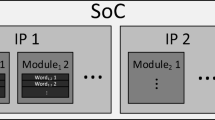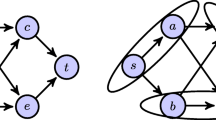Abstract
Model-order reduction (MOR) is a typical approach to speed up the post-layout verification simulation step in circuit design. This paper studies the benefits of using circuit partitioning in a complete MOR flow. First, an efficient reduction algorithm package comprising of partitioning, reduction, and realization parts is presented. The reduction flow is then discussed using theoretical analysis and simulations from an array of 65-nm technology node interconnect circuits. It is shown that the reduction efficiency and computational costs quickly worsen with increased circuit size when using a direct projection-based MOR approach. In contrast, by using partitioning, the MOR can retain the scalability of the reduction problem, being computationally lighter and more efficient even with larger circuits. In addition, using partitioning may improve the robustness of the MOR flow in cases with circuits with many ports or sensitive verification simulations.










Similar content being viewed by others
References
Corporation AWR–APLAC (2013) APLAC — Circuit simulation and design tool, Version 8.7 Manuals. AWR–APLAC Corporation, Espoo, Finland
Devgan A, O ′Brien PR (1999) Realizable reduction for RC interconnect circuits. In: Proceedings of IEEE ICCAD
Freund RW (2004) SPRIM: Structure-preserving reduced-order interconnect macromodeling. In: Proceedings of the IEEE ICCAD
Freund RW (2011) The SPRIM algorithm for structure-preserving order reduction. In: Lecture notes in electrical engineering 74, model reduction for circuit simulation. Springer, pp 25–52
Gilbert JR, Moler C, Schreiber R (1992) Sparse matrices in MATLAB: design and implementation. SIAM J Matrix Anal Appl 13 (1): 333–356
Golub GH, Loan CFV (1989) Matrix Computations. Johns Hopkins University Press, Baltimore
Han E-H, Karypis G, Kumar V, Mobasher B (1997) Clustering based on association rule hypergraphs. In: Workshop on research issues on data mining and knowledge discovery
Honkala M, Miettinen P, Roos J (2010) Hierarchical model-order reduction flow. In: Mathematics in industry 14, scientific computing in electrical engineering SCEE 2008. Springer, pp 539–546
Ionutiu R, Rommes J, Schilders WHA (2011). IEEE Trans Comput-Aided Des Integr Circuits Syst 30 (12): 1828–1841
Karypis G, Kumar V (2007). hMETIS, A hypergraph partitioning package (version 1.5.3). http://glaros.dtc.umn.edu/gkhome/metis/hmetis/download
Karypis G, Kumar V (2007). METIS, A software package for partitioning unstructured graphs, partitioning meshes, and computing fill-reducing orderings of sparse matrices (Version 4.0). http://glaros.dtc.umn.edu/gkhome/metis/metis/download
Karypis G (2014) Family of graph and hypergraph partitioning software, Karypis Lab. University of Minnesota, Minneapolis. http://glaros.dtc.umn.edu/gkhome/views/metis
Kundert KS (1995) Designer’s guide to SPICE and SPECTRE. Kluwer Academic Publishers, Norwell
Lee Y-M, Cao Y, Chen T-H, Wang JM, Chen C (2005) HiPrime: Hierarchical and passivity preserved interconnect macromodeling engine for RLCK power delivery. IEEE Trans Comput-Aided Des Integr Circuits Syst 24(6):797–806
Li D, Tan SX-D, Wu L (2009). Itegr VLSI J 42:193–202
Liao H (1995) Scattering-parameter-based macromodel for transient analysis of interconnect networks with nonlinear terminations. PhD thesis Univ., California at Santa Cruz
Miettinen P, Honkala M, Roos J, Valtonen M (2011) PartMOR: Partitioning-based realizable model-order reduction method for RLC circuits. IEEE Trans Comput-Aided Des Integr Circuits Syst 30 (3): 374–387
Miettinen P, Honkala M, Roos J, Valtonen M (2012) Improving model-order methods by singularity exclusion. In: Mathematics in industry 16, scientific computing in electrical engineering SCEE 2010. Springer, pp 387–394
Miettinen P, Honkala M, Roos J, Valtonen M (2012) Partitioning-based reduction of circuits with mutual inductances. In: Mathematics in industry 16, scientific computing in electrical engineering SCEE 2010. Springer, pp 395–404
Miettinen P, Honkala M, Roos J, Valtonen M (2013) Admittance parameter formulation for realizable model-order reduction. In: Proceedings of the 2013 European conference on circuit theory and design (ECCTD), pp 1–4
Miettinen P, Honkala M, Roos J, Valtonen M (2013) Sparsification of dense capacitive coupling if interconnect models. IEEE Trans Very Large Scale Integr (VLSI) Syst 21 (10): 1955–1959
Nanoscale Integration and Modeling Group (2005) Predictive Technology Model. Arizona State University, Tempe. http://ptm.asu.edu
Nicholas H (2008) Functions of Matrices: Theory and Computation Society for industrial and applied mathematics, Philadelphia
Odabasioglu A, Celik M, Pileggi LT (1998). IEEE Trans Comput-Aided Des Integr Circuits Syst 17 (8): 645–654
Palenius T, Roos J (2004) Comparison of reduced-order interconnect macromodels for time-domain simulation. IEEE Trans Microw Theory Tech 52 (9): 2240–2250
Su YF, Wang J, Zeng X, Bai Z, Chiang C, Zhou D (2004) SAPOR: Second-order Arnoldi method for passive order reduction of RCS circuits. In: Proceedings of the IEEE ICCAD
Tan S X-D, Hei L (2007) Advanced model order reduction techniques in VLSI design. NY, New York
Yang F, Zeng X, Su Y, Zhou D (2007) RLCSYN: RLC equivalent circuit synthesis for structure-preserved reduced-order model of interconnect. In: Proceedings of the IEEE ISCAS
Zhao W, Cao Y (2006) New generation of Predictive Technology Model for sub-45 nm early design exploration. IEEE Trans Electron Devices 53 (11): 2816–2823
Zhong G, Koh C, Roy K (2002) On-chip interconnect modeling by wire duplication. In: Proceedings of the IEEE ICCAD
Acknowledgments
This work was partially funded by the Finnish national Graduate School in Electronics, Telecommunications and Automation. Financial support from the Nokia Foundation is acknowledged.
Author information
Authors and Affiliations
Corresponding author
Additional information
Responsible Editor: V. Champac
Rights and permissions
About this article
Cite this article
Miettinen, P., Honkala, M., Roos, J. et al. Benefits of Partitioning in a Projection-based and Realizable Model-order Reduction Flow. J Electron Test 30, 271–285 (2014). https://doi.org/10.1007/s10836-014-5451-y
Received:
Accepted:
Published:
Issue Date:
DOI: https://doi.org/10.1007/s10836-014-5451-y




